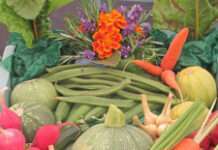K-State food scientist says when in doubt, throw it out
MANHATTAN, Kan. – While much of Kansas and the Midwest have been spared so far this year from severe weather, many people well know that winter’s freezing weather can descend rather quickly.
Kansas State University food scientist Karen Blakeslee said the break from cold weather is a chance for consumers to make sure they’re ready to keep their food safe in the event of a power outage.
She said something that can be done now is to put an appliance thermometer in the refrigerator and freezer.
“Some appliances have built-in thermometers but if the power is out, you won’t be able to read the temperature,” Blakeslee said. “As long as the temperature inside the appliance stays below 40 degrees F, the food will be safe.”
When a power outage occurs, consumers are best advised to keep the doors of the appliance closed as much as possible to keep cold air in.
“An unopened refrigerator will stay cold about four hours; a full freezer will hold temperature for about 48 hours,” Blakeslee said. “If you have access to dry ice, add some to the freezer to keep food frozen longer. However, use caution when handling dry ice.”
Storing food outside – such as in snow – can be risky and is not recommended, according to Blakeslee.
“This is due to fluctuating temperatures, physical damage due to curious pets or other animals, or contamination of the food from vehicle fumes, dust and grime,” she said.
If you’re not sure if food is safe, Blakeslee suggests following a familiar refrain: “When in doubt, throw it out!”
“If the appliance temperature goes above 40 F for a long period of time, some foods will be too warm and can invite the growth of bacteria that may be present,” she said. “For example, if frozen raw meat thaws out, and is warm to the touch, it should not be saved.”
Blakeslee pointed to a guide available online from the U.S. Food Safety and Inspection Service that outlines when to save and when to throw out potentially unsafe foods.
“While throwing out food due to an appliance failure or power outage is wasteful, it is a lot cheaper to do than paying for medical treatment due to foodborne illness,” she said.
Blakeslee, who also is coordinator of K-State’s Rapid Response Center for food science, publishes a monthly newsletter that addresses many food safety topics. This month’s newsletter includes a link to emergency food supply tips from Ready.gov.
More information on food safety and health practices also is available through K-State Research and Extension’s food safety website.
FOR PRINT PUBLICATIONS: Links used in this story
Consumers Guide to Food Safety (severe storms), www.fsis.usda.gov/wps/portal/fsis/topics/food-safety-education/get-answers/food-safety-fact-sheets/emergency-preparedness/a-consumers-guide-to-food-safety-severe-storms-and-hurricanes
Rapid Response Center for food science, www.rrc.ksu.edu
Emergency food supply tips, www.ready.gov/food
K-State Research and Extension food safety, www.ksre.k-state.edu/foodsafety
K State Research and Extension is a short name for the Kansas State University Agricultural Experiment Station and Cooperative Extension Service, a program designed to generate and distribute useful knowledge for the well being of Kansans. Supported by county, state, federal and private funds, the program has county extension offices, experiment fields, area extension offices and regional research centers statewide. Its headquarters is on the K State campus in Manhattan. For more information, visit www.ksre.ksu.edu. K-State Research and Extension is an equal opportunity provider and employer.
Story by:
Pat Melgares
785-532-1160
[email protected]
For more information:
Karen Blakeslee
785-532-1673
[email protected]





